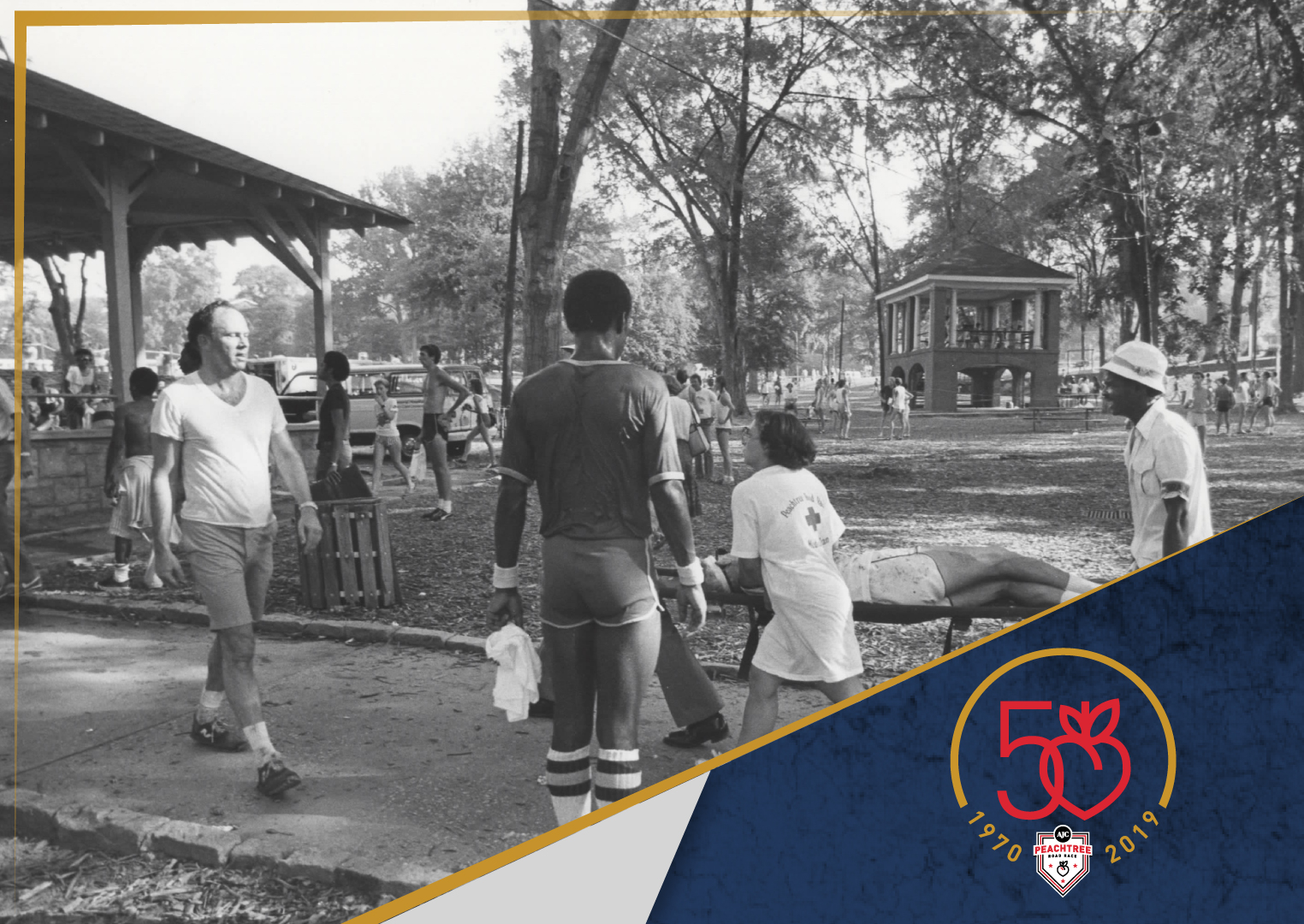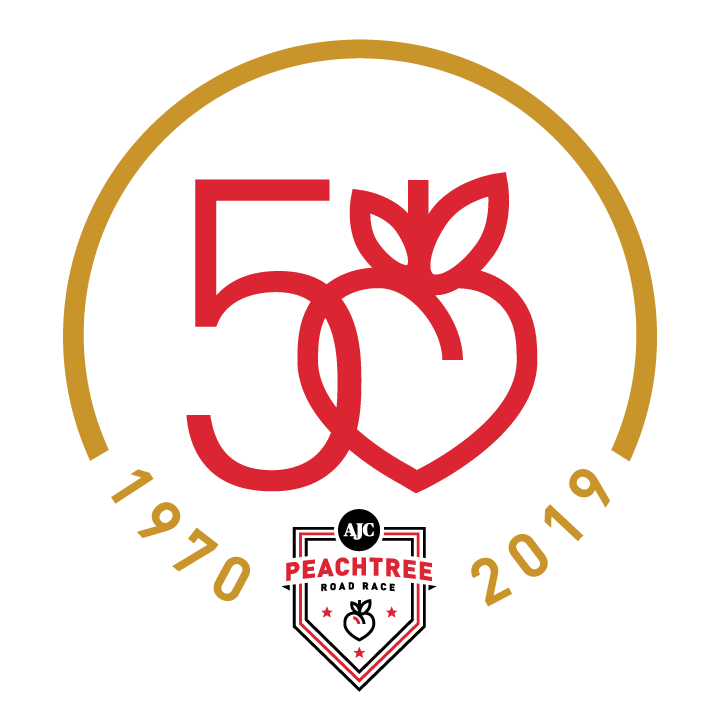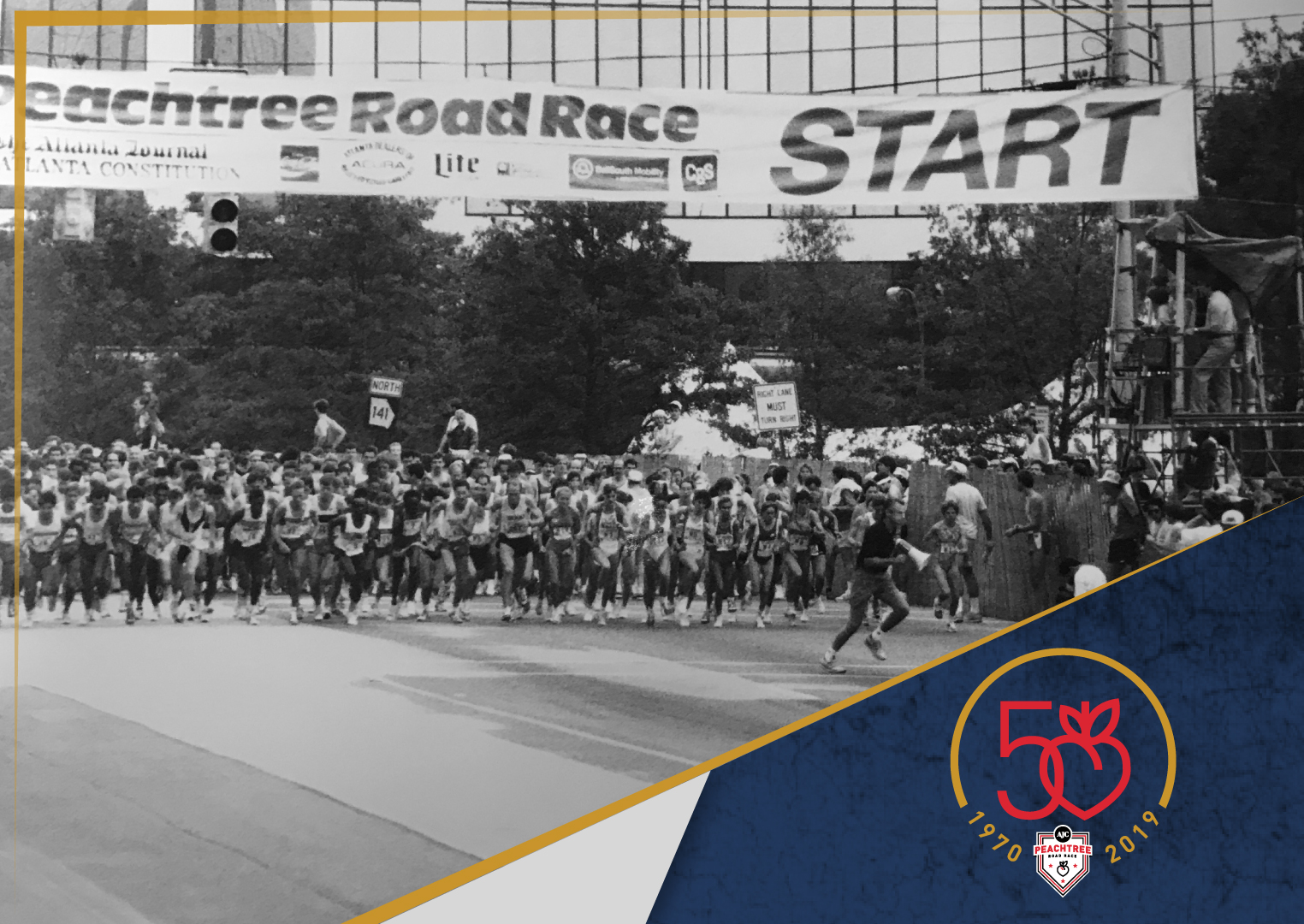A Medical Miracle

The distance between Tim Nelms and the finish line of the 2017 AJC Peachtree Road Race was about 100 yards. But the gap between the 61-year-old runner and life’s ultimate finish line was even narrower than that.
Nelms, of McDonough, Georgia, was running the race’s final leg with his daughter along Atlanta’s 10th Street when he went into sudden cardiac arrest and collapsed to the pavement.
“I remember going down toward the ground, but I don’t remember getting there,” Nelms later told reporters.
As fate would have it, an Emory University emergency medicine physician, Dr. Douglas Ander, was running only a few steps behind Nelms in the field of almost 60,000. Ander rushed over and began CPR until a team from the race’s nearby main medical tent arrived with an automated external defibrillator, or AED, to shock Nelms’ heart back into rhythm.
Nelms was then transported to Atlanta Medical Center, where a stent was inserted into the blocked artery that had precipitated his distress. He had lived to run another day.
The swift crisis response illustrated the extraordinary precision and preparation of the Peachtree’s medical team, which involves over 200 people in leadership and volunteer positions and has grown in 40 years from nothing into a finely tuned special-ops force.
“If you’re going to have a heart attack, the finish line at the Peachtree isn’t a bad place for it – not that we want it to happen to anyone,” said Rich Kenah, executive director of the Atlanta Track Club and race director for the Peachtree. “You get treated faster there than anywhere else you could be at the time.”
Consider this: Each of three medical tents in Piedmont Park, just beyond the race’s finish line, is populated with doctors, nurses, physical therapists, EMTs, medical transport assistants and registration personnel. The tents are set up like hospital emergency rooms, capable of administering everything from an electrocardiogram to IV fluids to basic medications. A sophisticated software program is deployed to track patients and transports.
The tent staffing doesn’t include the dozens of medics from Grady Hospital’s Emergency Medical Services and the Atlanta Fire Department, positioned on bicycles at one-mile intervals along the race course and ready with portable AEDs. They follow the runners and walkers all the way to the finish.
Hardly any of this medical arsenal ends up being needed, fortunately, but Atlanta’s notorious Fourth of July heat and humidity and the sheer volume of participants mean it’s no time to cut corners on safety.
Dr. Jonathan Kim, the Peachtree’s medical director, said the overwhelming percentage of the medical issues addressed on race day consist of heat-related ailments. In 2018, the tents saw 267 visitors – less than half of 1 percent of all starters – most of whom just needed to cool off. Only 18 participants were transported to hospitals for additional treatment or observation.
“The crux of our care is ice and cold towels for rapid cooling, and it always will be,” said Kim, a Boston-trained sports cardiologist, who relies on the support of Emory colleagues Dr. Lekshmi Kumar and Sam Shartar, a nursing administrator who provides emergency logistics expertise. Also assisting has been Dr. Perry Julien, who focuses on relatively minor injuries such as blisters and scrapes, and plans to retire after the 50th Running next year.
Atlanta Track Club adopted more of a team approach with the race’s medical leadership as Dr. Joe Wilson, the cardiologist who had been in charge for 30 years, transitioned out of the medical director’s role in 2016.
“I inherited an uber-successful medical operation led by Joe Wilson that was brilliant in its simplicity,” said Kenah, who became Peachtree race director in 2014. “He understood how to deal with heat-related injuries simply because, well, it’s the Fourth of July in Atlanta.
“When Dr. Wilson retired, I recognized that our hyper-dependence on volunteers made the Peachtree special but also a little scary,” said Kenah. At that point, the race added more doctors and built out a more-robust communications infrastructure, with the support of Atlanta Fulton County Emergency Management Agency and other city and state agencies. “We’ve made some small changes to Dr. Wilson’s already successful blueprint,” said Kenah.
Wilson has seen the race’s medical care at its best and worst. He was an intern at Grady Hospital on the Fourth of July in 1977, scheduled to work the emergency room in the morning and early afternoon, when he decided to swap shifts so that he could run his first Peachtree.
Although he had competed on a Georgia state championship cross country team at now-defunct Dykes High School, nothing could match the thrill of standing directly behind world-class runners Frank Shorter, Bill Rodgers and Lasse Virén on the Peachtree starting line in 1977. Partly because of the elites in that year’s field – there were eight Olympians in all – the race jumped to 6,500 runners from 2,350 the year before. The U.S. running boom was no rumor; it was verifiable fact.
Wilson’s pleasant memories of the day ended right there, or shortly thereafter. He was astonished by what he saw at the conclusion of 6.2 broiling miles in Central City Park (now Woodruff Park), which was then the finish line for the race. With no aid stations or medical care along the course – these were the primitive early years of road racing – the scene in the park was that of fallen bodies everywhere. The dehydrated, desperate survivors sought relief in the park’s fountain.
“It became obvious that a lot of people were not doing well,” Wilson said.
At least 60 runners went to the hospital that day, including one with a body temperature of 107 degrees, and Wilson said that five were admitted to intensive care.
Thankfully, no one died, although the Peachtree almost did. The next year, the course was changed to include a finish in Piedmont Park, where shade was plentiful, and the starting time was moved up two hours amid pressure from the Medical Association of Atlanta to call the whole thing off. (Even with the nightmarish 1977 race fresh in everyone’s mind, the number of runners nearly doubled, to 12,000.)
Also in 1978, a medical team finally was put in place, headed initially by Dr. Dan White and eventually by Wilson, who saw the medical director’s role as a way of repaying running for all that the sport had meant to him.
“If we’d had another year like [1977], they probably would have canceled the race,” Wilson said. “We had to make it a safer race.”
The heat, he said, determines everything about the medical approach. Temperature records for July 4 in Atlanta show that it’s usually in the low to mid 70s at the start of the race, which in 2018 was 7 a.m., a half-hour earlier than the previous year. But the muggiest time of the day falls around 9:30 a.m., when plenty of later-starting waves of participants are still out on the course. Water stops are available at every mile, and a color-coded alert system keeps participants apprised of conditions.
Typically, the need for care peaks with the fastest runners, who are pushing the pace hard and overheating, and then it spikes again later in the morning, when the temperature is a greater factor.
“Time becomes critical because of two conditions: cardiac arrest or a heat-related incident,” Wilson said. “I decided that we had to have a system to take treatment to the runners, to try to treat them where they were.
“A 104-degree body temperature is like having your hand in a fire. You want to take your hand out of the fire as soon as possible. You have to identify those expressing symptoms and get them to a place where they can be cooled as soon as possible.”
The explosive growth of the race in participants and spectators eventually made the use of ambulances impractical, so the bike teams were developed in the mid-1990s to enhance rapid response. Over the years about a dozen participants have survived cardiac arrest during the race. The chances of survival improve dramatically with the prompt use of a defibrillator to shock the heart.
“You have only two or three minutes of time in that situation,” Wilson said.
In the 49-year history of the world’s largest 10k, there have been only three fatalities – all from cardiac arrest – in an estimated 1.7 million registrants. Thus, the chance of dying while running the Peachtree comes out to roughly 1 in 566,000, compared to a 1 in 7 chance of dying from heart disease and a 1 in 161,856 chance from a lightning strike, according to the National Safety Council.
“Running the Peachtree is not dangerous,” said Kenah. “But for those who do require serious medical attention, they often need it urgently.”
Kim said that one recent improvement in care has been an increased presence by Grady EMS in The Meadow in Piedmont Park, where finishers are observed for signs of heat-related illness.
Kumar, an ER doctor who moved to Atlanta from Minnesota on July 2, 2010, and worked the Peachtree two days later for Grady EMS, said that even a detail such as having golf carts equipped to transport more than one patient at a time can make a difference.
“The significant challenge is how best to cool these people,” said Kumar, who also serves as medical director for the Publix Atlanta Marathon in March, when the weather is cooler and for which participants tend to train more. “The Atlanta Track Club is awesome and understands why we need to go through all that we do.”
Assessment of everything that potentially could go wrong is Shartar’s business, and he said it demands an “all-hazards” approach to planning.
“It’s everything from a terror attack, which is low in likelihood but high in consequence, to a lightning strike in Piedmont Park to the heat that we always have,” said Shartar, who came on board with the Peachtree in the wake of the Boston Marathon attacks in 2013.
“The volume of runners has been consistent, and the heat in Atlanta hasn’t changed much in 50 years. The event is still manageable. If we had an unusual heat wave of 100-plus temperatures, we’d have to take a look at the safety. But at this point it’s manageable.”
Wilson, who now runs a medical malpractice insurance company, said the race simply couldn’t be done without the volunteer army that faithfully turns out to help, year after sweltering year.
“The volunteers don’t get the holiday off,” he said. “My heart always went out to all the nurses. They’re the heroes, the ones who are trained in treating patients. … I wasn’t making decisions. It was the people in the field who were doing that.”
And sometimes the people in the field of runners do it. You can’t help but appreciate an event where a doctor from one of the country’s most prominent medical schools is running right behind a man who goes into cardiac arrest — and immediately jumps in to assist.
“Basically, I died,” Nelms told reporters. “I mean, my heart stopped. I would have [died] if somebody hadn’t been there to resuscitate me. Everything I could have wished for was probably more readily available [at the finish line] than even in a hospital.”
Nelms and Dr. Douglas Ander celebrated in 2018 in a very Atlanta way: They ran the Peachtree again. Together.
Atlanta Track Club's staff and the Peachtree committee in 2006









